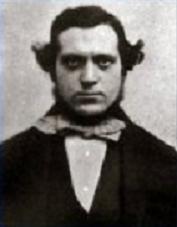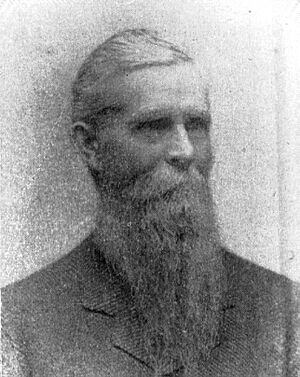Morrisite War facts for kids
Quick facts for kids Morrisite War |
|||||||
|---|---|---|---|---|---|---|---|
| Part of the Mormon Wars | |||||||
|
|||||||
| Belligerents | |||||||
| Morrisites | |||||||
| Commanders and leaders | |||||||
| Joseph Morris † | |||||||
| Strength | |||||||
| 200 - 500 Morrisite followers | 1,000 members of the territorial militia | ||||||
| Casualties and losses | |||||||
| Eight Morrisites (including at least four women) | One militia member | ||||||
The Morrisite War was a short fight in June 1862. It happened between a religious group called the "Morrisites" and the government of Utah Territory.
Contents
Who Were the Morrisites?
In 1857, a man named Joseph Morris moved to Utah. He was from England and had joined The Church of Jesus Christ of Latter-day Saints. Joseph Morris said he was getting special messages, or "revelations," from God. He believed these messages meant he was a special angel mentioned in the Book of Revelation. He even wrote to Brigham Young, who was the leader of the church at that time, to tell him about his new role.
In 1860, Joseph Morris started to gather people who believed his messages. This group became known as the Morrisites. In February 1861, church leaders John Taylor and Wilford Woodruff removed him from their church. This is called "excommunication." On April 6, 1861, Morris started his own church, called the Church of the Firstborn. He asked all his followers to come together at Kington Fort. This fort was about 3-acre (12,000 m2) big and was on the Weber River. It had been empty since 1858. By the fall of 1861, hundreds of people had joined the Morrisites at the fort.
Morris told his followers that the Second Coming of Jesus was going to happen very soon. Because of this, he told them not to bother planting crops. Some people even stomped their crops into the ground to show how much they believed. The group shared all their food and supplies. They waited at Kington Fort for the Second Coming.
Problems Begin for the Morrisites
By the spring of 1862, food was running low at Kington Fort. Some members of the group started to get unhappy. Joseph Morris kept saying that the Second Coming would happen on certain days. But each time, nothing special happened. When this occurred, a few members would take their belongings back from the shared supplies and leave the group.
As more people left, there were arguments about who owned what. The people who stayed felt that those who left were taking better animals and other items than they had put in. Three members who were leaving – William Jones, John Jensen, and Lars C. Geertsen – were very angry. They felt they had been treated unfairly. They decided to take some wheat that was being moved from Kington Fort to a mill. The Morrisites sent a group of men after them. They caught the three men and took the wheat back. The Morrisites then held the three men prisoner in a small building.
Government Gets Involved
Lars Geertsen managed to escape from the fort. But the wives of the other two prisoners asked the government for help. The news reached John F. Kinney, who was the chief judge of the Utah Territory. He heard that the Morrisites were holding people against the law. On May 24, Judge Kinney issued a special order called a "writ of habeas corpus." This order demanded that the prisoners be set free.
U.S. Marshal Judson Stoddard took the order to Kington Fort. He read it to the Morrisite leaders, but they refused to accept it.
The Fight at Kington Fort
Three weeks later, the Morrisites still had not followed the judge's order. So, Chief Judge Kinney asked the acting governor to call out the territorial militia. A militia is a group of citizens who can act as soldiers in an emergency. On June 12, about 200 armed men left Salt Lake City to go to the fort. The fort was about 30 miles (48 km) north. Robert T. Burton, a deputy U.S. Marshal, led this group. More people joined them along the way. By the time they reached Kington Fort on June 13, there were between 500 and 1,000 men. The Morrisites had built barricades to protect themselves inside the fort.
The militia set up their positions around the fort. They placed cannons on two small hills that pointed right into the fort. The fort itself was a simple enclosure made to hold hundreds of people. Another group of militia from Ogden positioned themselves to the north.
Burton sent a message to the Morrisites using a young boy who herded their animals. He told them to surrender within 30 minutes. When Joseph Morris got the message, he went away for a moment. He came back saying he had a new revelation. He told his people that the militia would be destroyed. He and his helpers blew a bugle to gather everyone and read the new message.
When the Morrisites did not surrender after 30 minutes, Burton ordered two warning shots to be fired. He wanted to make them decide faster. The second cannonball bounced off the ground and went into the fort. It sadly killed two women and hurt another woman named Mary Christoffersen. Some Morrisites then fired back. They killed 19-year-old Jared Smith, who was part of the militia. He was the only person killed who was not a Morrisite.
Heavy rain on June 14 stopped most of the fighting. What happened on June 15 is not fully clear. But at some point, Burton rode into the fort with a small group of his men. Details are still fuzzy, but Joseph Morris may have spoken to his followers and then approached Burton in a way that seemed threatening. Burton killed Morris. Two more women were also killed in the confusion that followed. Morris's helper, John Banks, was badly hurt and died later. Burton took 90 men prisoner. He marched them back to Salt Lake City the next morning to face a judge.
What Happened After the War?
In March 1863, seven of the Morrisites were found guilty of serious actions. Another 66 were found guilty of resisting the law. However, Stephen S. Harding, who was the new governor appointed by the government, pardoned all of them just three days after they were found guilty. A pardon means they were forgiven and released.
The Morrisites then spread out across the western United States. Many of them settled in Deer Lodge County, Montana. A building they used for worship in Racetrack, Montana, is still standing today, though it needs repairs.
Seven years later, Robert T. Burton was put on trial. He was accused of causing the death of Isabella Bowman, one of the women killed after the fort was attacked. However, he was found not guilty.
Remembering the Morrisite War
A monument was put up in South Weber, Utah, to remember the Morrisite War. It was built by groups like the Daughters of Utah Pioneers and Sons of Utah Pioneers. The monument tells the story of the three-day battle that happened in June 1862. It explains that Kington Fort was built in 1853 to protect early settlers. It was empty by 1858 before the Morrisites used it. The monument also describes how the conflict started when the Morrisites held prisoners. It mentions the militia's arrival and the sad deaths that occurred during the fight. After their leaders died, the Morrisites moved to different places like Soda Springs, Idaho, Carson City, Nevada, and Deer Lodge, Montana. Some even rejoined The Church of Jesus Christ of Latter-day Saints.





